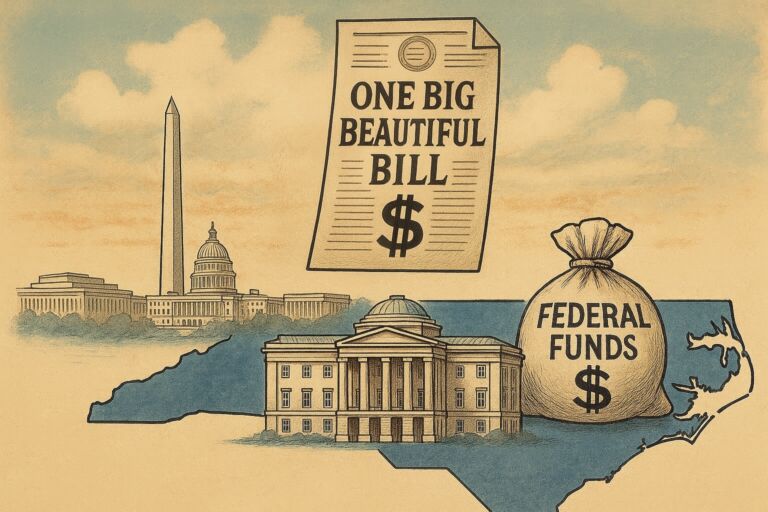Over the last four decades, North Carolina has become increasingly dependent on federal funding, gradually weakening its autonomy. This shift from traditional federalist principles — once central to the balance of power in American governance — is most evident in the state’s 2023 decision to expand Medicaid, extending coverage to young, able-bodied adults in exchange for increased federal funding.
Medicaid is a joint federal-state program, with the federal government matching a portion of each state’s spending. For traditional groups like the disabled, the federal match ranges from 50 to 83 percent, depending on the state’s relative wealth. In contrast, the match rate for Medicaid expansion enrollees is 90 percent, regardless of state income.
Many states, including North Carolina, impose taxes on health care providers to cover their share of Medicaid costs. The One Big Beautiful Bill Act (OBBBA) incrementally reduces the cap on these “provider taxes” from 6 to 3.5 percent, a change that could dismantle North Carolina’s Medicaid expansion financing model, which depends on these taxes to fund the state’s 10 percent share.
The remainder of this article explores North Carolina’s growing reliance on federal funding since the 1980s, compares these trends to neighboring states, and highlights the OBBBA as a current example of the fiscal dangers of dependence on federal funding.
For North Carolina, the share of General Fund revenues from federal funds has more than doubled over the past four decades.
Federal revenue trends
The state’s Annual Comprehensive Financial Report (ACFR) provides data on federal revenues the state receives each fiscal year.
Revenue data for fiscal year (FY) 1988 to 2024 were collected from North Carolina’s ACFRs. For comparison, data from the ACFRs of South Carolina and Virginia were collected for FY 1997 to 2024; in each case, the share of federal revenue as a percentage of total General Fund revenue was calculated. To ensure consistency across states, General Fund revenues were adjusted to exclude revenues dedicated to transportation, such as motor fuel taxes.
For North Carolina, the share of General Fund revenues from federal funds has more than doubled over the past four decades. In FY 1988, the share of funds provided by the federal government accounted for 20 percent of the state’s General Fund revenue. By FY 2024, that share increased to 46 percent.
It is worth noting that dependence on federal funds accelerated during recessionary periods, with the share of federal revenue for North Carolina rising from 33 to 43 percent during the Great Recession, FY 2007 to 2010, and 38 to 47 percent during the COVID-19 pandemic, FY 2019 to 2022, driven by substantial federal stimulus.

As a prime example of this effect, consider the federal funds provided to North Carolina for the COVID-19 response. Since FY 2020, the total has amounted to nearly $23 billion, with more than one-third of that amount received in FY 2023 or 2024 after the pandemic subsided.

Comparing this impact on North Carolina with neighboring states, we find similar patterns. From FY 2007 to 2010 and from FY 2019 to 2022, South Carolina saw its share of federal revenues increase from 34 to 46 percent and from 37 to 43 percent, while Virginia experienced its respective share of federal funding increase from 25 to 38 percent and from 31 to 42 percent during the same periods.

During recessions, the federal share of state revenues spikes sharply. While it declines somewhat afterward, it fails to return to pre-recession levels. A higher baseline is established each time, gradually expanding the federal government’s influence over state budgets.
Relative to the neighboring states, North Carolina has maintained a high federal revenue share after the peak of the COVID-19 pandemic, making it particularly susceptible to federal funding cuts.

One Big Beautiful Bill Act
The OBBBA could decrease funding for North Carolina Medicaid by billions annually. Thankfully, the 2023 legislation that authorized Medicaid expansion in North Carolina included a safeguard: if the authorized revenue sources cannot fully fund the nonfederal share of the cost, the state will discontinue expansion coverage.
The approved revenue sources include gross premium taxes, intergovernmental transfers, hospital health advancement assessments (provider taxes), and expansion-related state budget savings.
Currently, provider taxes are the primary funding source for the state’s share of Medicaid expansion. This approach has enabled the state to draw the 90 percent federal matching funds without relying on state appropriations.
However, the OBBBA lowers the maximum provider tax rate the state can charge, reducing the provider tax revenue available to fund the state’s share of the cost. If revenue from this source falls low enough, the 2023 safeguard will kick in, leaving North Carolina legislators with a difficult political decision: raise other taxes, reduce eligibility and coverage, or terminate Medicaid expansion.
Policy recommendation
The federal government is more than $37 trillion in debt. North Carolina should uphold the 2023 safeguard provision and prepare to discontinue Medicaid expansion. Attempting to continue the expansion program would be fiscally irresponsible and risk continued coverage for the traditional Medicaid population.
To ensure long-term financial stability and protect state sovereignty, policymakers must begin laying the groundwork to reduce North Carolina’s reliance on federal funding.
The post North Carolina and the Big Beautiful Bill: A cautionary tale of federal reliance first appeared on John Locke Foundation.
Click this link for the original source of this article.
Author: Joseph Harris
This content is courtesy of, and owned and copyrighted by, https://www.johnlocke.org and its author. This content is made available by use of the public RSS feed offered by the host site and is used for educational purposes only. If you are the author or represent the host site and would like this content removed now and in the future, please contact USSANews.com using the email address in the Contact page found in the website menu.








